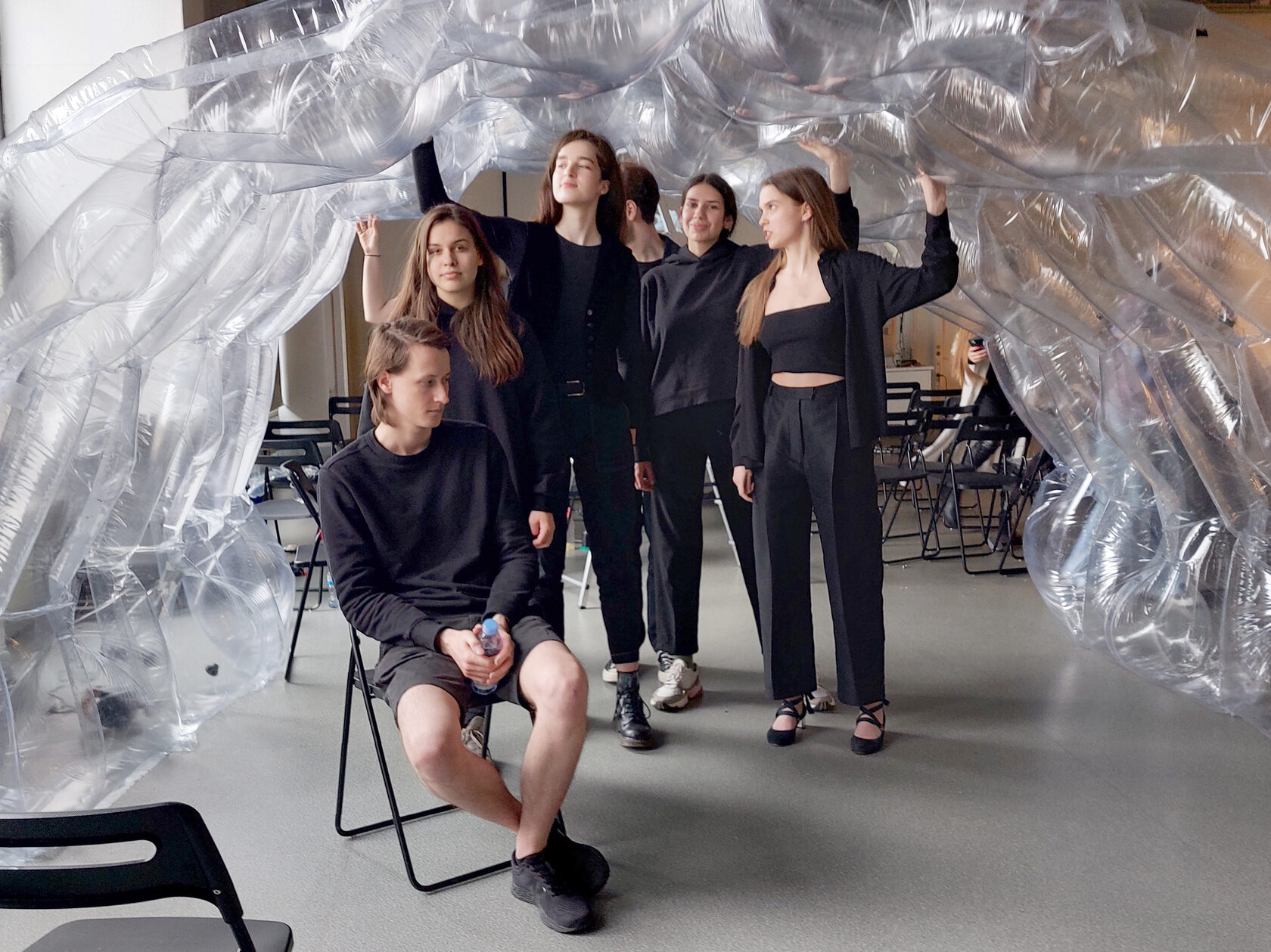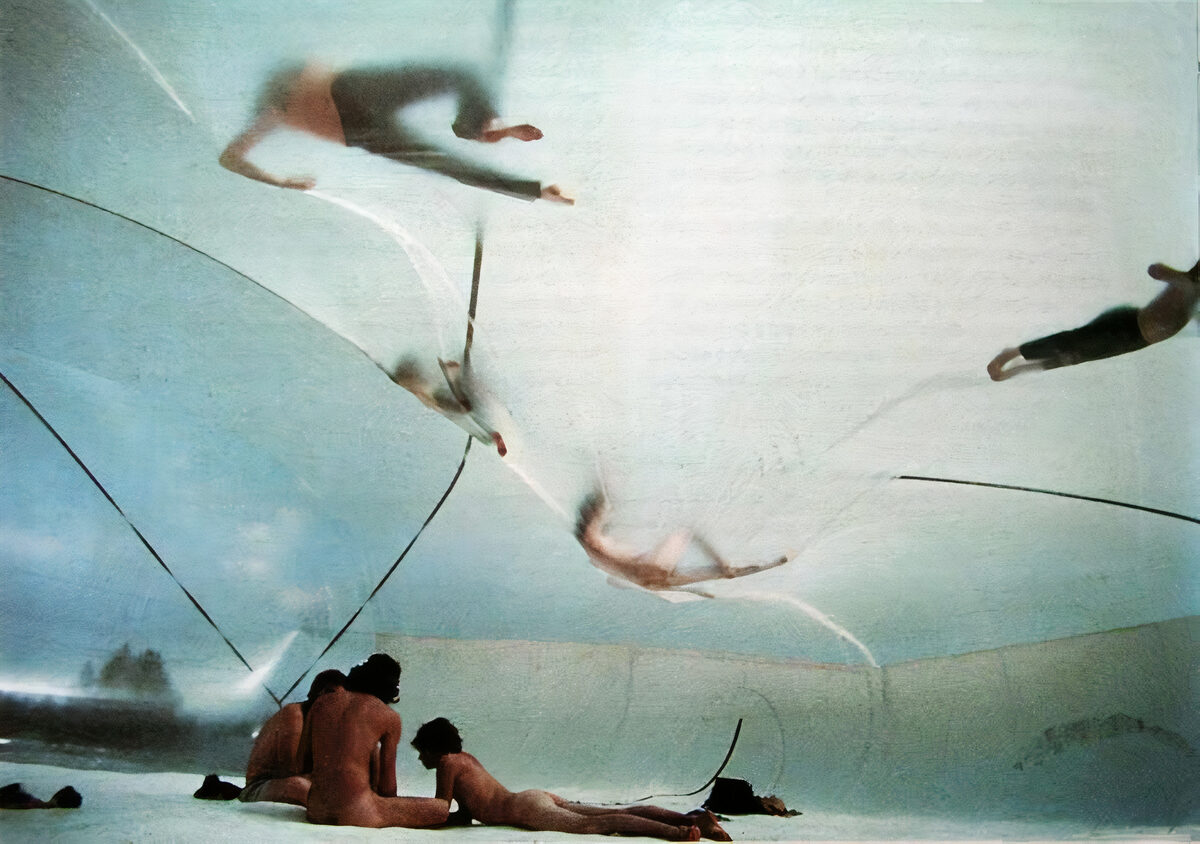
PNEU
MARCH — Technology module. ВА2 2020-2021.
Daria Andreeva, Eric Dorin, Polina Kropacheva, Katya Novoseltseva, Ilya Pigarev, Tatiana Tsaplina, Arina Chervyakova
Teachers: D. Kovaleva, V. Grudsky, V. Veremchuk
Curator: I. Tomovich
Daria Andreeva, Eric Dorin, Polina Kropacheva, Katya Novoseltseva, Ilya Pigarev, Tatiana Tsaplina, Arina Chervyakova
Teachers: D. Kovaleva, V. Grudsky, V. Veremchuk
Curator: I. Tomovich
The word pneu, which has already been the title of our study from the outset, refers to all the important questions that we have tried to answer in our varied and numerous experiments. The work and study of the various hypostases of pneumatic structures made it possible to understand this seemingly familiar and trivial variety of lightweight construction, and at the same time all the subtleties that have become a tool for us to transform primitive principles into more complex systems.
THE PNEU PRINCIPLE
If we simplify the pneumatic principle as much as possible, we get an axiom in the form of a flexible and tensile resistant shell, filler and environment (shell - filler - medium).
The shell and the filler together with the medium form a single structural system capable of absorbing internal and external forces. If the filler is, for example, air, the pressure inside the shell tends to be uniformly distributed at each section of the enclosed volume. When the system achieves a uniform distribution of internal pressure and shell tension, its load-bearing capacity becomes quite competitive in all kinds of loads.
If we simplify the pneumatic principle as much as possible, we get an axiom in the form of a flexible and tensile resistant shell, filler and environment (shell - filler - medium).
The shell and the filler together with the medium form a single structural system capable of absorbing internal and external forces. If the filler is, for example, air, the pressure inside the shell tends to be uniformly distributed at each section of the enclosed volume. When the system achieves a uniform distribution of internal pressure and shell tension, its load-bearing capacity becomes quite competitive in all kinds of loads.

PNEUMATIC STRUCTURES IN ARCHITECTURE
In the post-war period, the idea of pneumatic structures became particularly popular. The Ant Farm group, consisting of 3 architects, was inspired by the idea of creating a completely light and free transparent shell in which people could live, or even grow plants.
In the post-war period, the idea of pneumatic structures became particularly popular. The Ant Farm group, consisting of 3 architects, was inspired by the idea of creating a completely light and free transparent shell in which people could live, or even grow plants.

Inflatables by Ant Farm, California, 1970
SEARCH PATTERNS
The aim of the experiments was to learn how to control pneumatic structures.
We started by identifying areas of research from simple pneumatic structures (balls, nets) to more complex and combined ones. For each of the directions we produced a number of experiments, about 100 in total. As the experiments became more complex, so did the technological features of fabrication. This became a separate task for experiments with different materials and tools.
The aim of the experiments was to learn how to control pneumatic structures.
We started by identifying areas of research from simple pneumatic structures (balls, nets) to more complex and combined ones. For each of the directions we produced a number of experiments, about 100 in total. As the experiments became more complex, so did the technological features of fabrication. This became a separate task for experiments with different materials and tools.

THE CREASING PRINCIPLE
We then realised that we could modify the shape of the cut-outs and the methods of joining them together. In particular, we determined that a structure sewn from two unequal length halves could take the form of an arch, and that by scaling such a structure a person could walk underneath it. One of the first methods of obtaining an arch was the "folding" principle. More material is used on one of the planes, so that when inflated, the shape curves. Examples of the application of this principle can be seen here.
We then realised that we could modify the shape of the cut-outs and the methods of joining them together. In particular, we determined that a structure sewn from two unequal length halves could take the form of an arch, and that by scaling such a structure a person could walk underneath it. One of the first methods of obtaining an arch was the "folding" principle. More material is used on one of the planes, so that when inflated, the shape curves. Examples of the application of this principle can be seen here.

THE ROMB PRINCIPLE
You can also use the principle of rhombus-shaped joints to control the shape of the design. Depending on the proportions and opening of the rhombus, the bending angle when inflating also changes. Examples of the application of this principle can be seen here.
You can also use the principle of rhombus-shaped joints to control the shape of the design. Depending on the proportions and opening of the rhombus, the bending angle when inflating also changes. Examples of the application of this principle can be seen here.

DIGITAL MODELLING
The behaviour of pneumatic structures can be simulated quite accurately in a digital environment. For this purpose, we used Rhino/Grasshopper and the Kangaroo Physics plug-in, in which we simulated the behaviour of pneumatic structures with irregular rhomboids using mass-spring models.
The behaviour of pneumatic structures can be simulated quite accurately in a digital environment. For this purpose, we used Rhino/Grasshopper and the Kangaroo Physics plug-in, in which we simulated the behaviour of pneumatic structures with irregular rhomboids using mass-spring models.

Digital shaping of pneumatic structures in Kangaroo Physics
SCALING. ARCH
One of the experiments was an arch, 4 metres long. We made a system of different rhombuses and determined the order and extent of their opening. After determining the principle and order of the rhombuses, we made half of the arch to verify the method we had chosen. The experiment was successful, the construction held its shape and pressure without the help of a compressor.
One of the experiments was an arch, 4 metres long. We made a system of different rhombuses and determined the order and extent of their opening. After determining the principle and order of the rhombuses, we made half of the arch to verify the method we had chosen. The experiment was successful, the construction held its shape and pressure without the help of a compressor.

THE FINAL MODEL
The structure consists of five chambers with a total area of 30.8 m2, which are separated by a six-centimetre seam and communicate via integrated end chambers. It took us 38 hours of work to build. A lot of time was spent measuring and adding up the necessary amount of material. First, we soldered 2 sheets of material around the perimeter, then proceeded to solder 36 rhombuses. The final design uses an orthogonal arrangement of the diamond axes. We purposely avoided 'sharp' corners and rounded the diamond shapes to reduce material tension and avoid holes.
The structure consists of five chambers with a total area of 30.8 m2, which are separated by a six-centimetre seam and communicate via integrated end chambers. It took us 38 hours of work to build. A lot of time was spent measuring and adding up the necessary amount of material. First, we soldered 2 sheets of material around the perimeter, then proceeded to solder 36 rhombuses. The final design uses an orthogonal arrangement of the diamond axes. We purposely avoided 'sharp' corners and rounded the diamond shapes to reduce material tension and avoid holes.

CONCLUSION
The final construction showed the right approach, materials, technology and structural method. The entire structure was quite inexpensive compared to the more labour-intensive, heavy and expensive structures of other groups. Transport is no problem, the production speed, if it were automated, would take hours, and the overall cost would be even lower.
The final construction showed the right approach, materials, technology and structural method. The entire structure was quite inexpensive compared to the more labour-intensive, heavy and expensive structures of other groups. Transport is no problem, the production speed, if it were automated, would take hours, and the overall cost would be even lower.
As we were limited in resources and the ability to order materials, the quality of the final design was also affected. Although it shows convincing resilience, the pressure in the system is still lacking. The fact is that each new scale also needed a consistent evolution of materials and tools. The material would have to become much thicker, consequently the irons would have to operate at even higher temperatures, and the compressor would have to lift the structure even more weight.
LITERATURE
IL 9 Pneus in Natur Und Technik. Universität Stuttgart, and Eda Schaur
IL 12 Convertible Pneus. Universität Stuttgart, and Eda Schaur
IL 19 Growing and Dividing Pneus. Universität Stuttgart, and Eda Schaur
IL 35 Pneu and Bone. Universität Stuttgart, and Eda Schaur
Ермолов, В. В., У. У. Берд, and Э. Бубнер. "Прошлое, настоящее и будущее пневматических строительных конструкций." Пневматические строительные конструкции.-М.: Стройиздат (1983)
Ou, Jifei, et al. «aeroMorph-heat-sealing inflatable shape-change materials for interaction design.» Proceedings of the 29th Annual Symposium on User Interface Software and Technology. 2016
IL 9 Pneus in Natur Und Technik. Universität Stuttgart, and Eda Schaur
IL 12 Convertible Pneus. Universität Stuttgart, and Eda Schaur
IL 19 Growing and Dividing Pneus. Universität Stuttgart, and Eda Schaur
IL 35 Pneu and Bone. Universität Stuttgart, and Eda Schaur
Ермолов, В. В., У. У. Берд, and Э. Бубнер. "Прошлое, настоящее и будущее пневматических строительных конструкций." Пневматические строительные конструкции.-М.: Стройиздат (1983)
Ou, Jifei, et al. «aeroMorph-heat-sealing inflatable shape-change materials for interaction design.» Proceedings of the 29th Annual Symposium on User Interface Software and Technology. 2016
Ant Farm, Inflatocookbook, Mock-up. Ant Farm, 1970
Phil Ayers, et al. Inflated Restraint
Schaur, Eda, and Universität Stuttgart, editors. Pneus in Natur und Technik =: Pneus in nature and technics. Krämer, 1977
Huijben, F., F. Van Herwijnen, and R. Nijsse. «Vacuumatics 3D-formwork systems: customised free-form solidification.» Structural Membranes (2009): 1-4
Velikov, Kathy, Geoffrey Thun, and Mary O'Malley. «PneuSystems: cellular pneumatic envelope assemblies.» (2014)